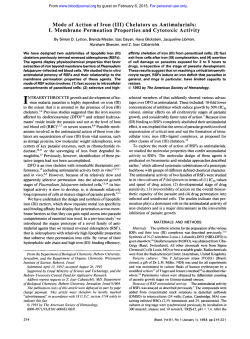
Neutron Dosimetry and Neutron Capture Model for Palladium
46th Lunar and Planetary Science Conference (2015) 2369.pdf NEUTRON DOSIMETRY AND NEUTRON CAPTURE MODEL FOR PALLADIUM-SILVER CHRONOMETRY OF IRON METEORITES. M. Matthes1, M. Fischer-Gödde1, T. S. Kruijer1, I. Leya2 and T. Kleine1, 1Institut für Planetologie, Westfälische Wilhelms-Universität Münster, 48149 Münster, Germany, 2Space Research and Planetology, University of Bern, Bern, Switzerland ([email protected]). Introduction: The short-lived 107Pd-107Ag system (t1/2 = 6.5 Ma) is a powerful chronometer for constraining the accretion and cooling histories of iron meteorite parent bodies [1-4]. However, exposure of the iron meteoroids to galactic cosmic rays (GCR) may have modified the Ag isotope compositions. This not only involves neutron capture-induced burnout of Ag isotopes, but also production of Ag via neutron capture on Pd isotopes [5]. Therefore, the net GCR effect on Ag isotope compositions increases with increasing Pd/Ag. Hence, although high-Pd/Ag iron meteorites can be very well dated using the Pd-Ag system, these meteorites may also show the largest GCR-induced shifts on 107 Ag/109Ag. Thus, applying the Pd-Ag system to iron meteorites requires a quantitative assessment of neutron capture effects in each sample. The objectives of this study are to evaluate the significance of GCR-induced shifts on 107Ag/109Ag ratios in iron meteorites and to develop a method for correcting these effects. Such a correction method requires an independent neutron-dose proxy, and a model linking this dosimeter to the effects on 107Ag/109Ag. To this end we have extended the model calculations of GCRinduced effects on Pd-Ag systematics from Leya and Masarik [5] with calculations of neutron capture effects on Pt isotopes, which provide a powerful neutrondose proxy for iron meteorites [6,7]. The updated model makes it possible to correct GCR-induced effects on 107Ag/109Ag using Pt isotope compositions. To test the model, we obtained combined Pd-Ag and Pt isotope data for several splits of the iron meteorites Ainsworth (IIAB), Carbo and Rodeo (IID) as well as Grant (IIIAB). The first two of these samples are among the most strongly irradiated iron meteorites and, hence, ideally suited to study GCR-induced shifts on 107Ag/109Ag ratios, and for testing the newly developed correction method. Analytical methods: All samples were polished using SiC abrasives, cleaned by ultrasonication in deionized water, and leached in warm 6 M HCl. After dissolution of the samples (1-3 g) in hot reverse aqua regia, three different aliquots were taken for the determination of Pd and Ag concentrations and Pt isotope compositions. A three-column ion exchange procedure, adapted and slightly modified from [3,8], was used for the purification of Ag. The separation of Pt followed the method of [6]. All isotope measurements were performed on the Thermo Scientific® Neptune Plus MC- ICPMS in the Institut für Planetologie, using either an ESI APEX-Q (for Ag) or a Cetac Aridus II desolvating system (for Pt). Prior to measurement the Ag fractions were doped with Pd for mass bias correction relative to 108 Pd/106Pd = 0.97237. The Ag isotope data for samples are reported in ε107Ag as the parts per 10,000 deviations from the mean 107Ag/109Ag obtained for measurements of bracketing runs of the NIST 978a standard. The reproducibility of the Ag isotope measurement is ±2 ε107Ag (2s.d.), as estimated from repeated measurements of the NIST 129c steel. The Pt isotope measurements followed the protocols described in [6]. Neutron capture model: The model calculations follow those presented earlier [5]. We consider thermal and epithermal neutron capture reactions as well as reactions induced by fast particles (i.e., protons and neutrons with energies of a few MeV) on Ag, Pd, and Cd to fully cover all possible reaction pathways. The modeled GCR-induced shift on ε107Ag depends on the Pd/Ag ratio, because neutron capture on 106Pd and 108 Pd produces, after subsequent β--decay, 107Ag and 109 Ag. In addition, the GCR-induced effects also depend on the neutron dose, which itself is a function of exposure time, pre-atmospheric radius of the meteoroid, and the shielding depth of the sample in the preatmospheric object. Consequently, for correcting GCRinduced effects on ε107Ag two parameters must be considered, namely the Pd/Ag ratio and the neutron dose. For the latter we use the isotopic shifts in Pt isotopes, which are well suited for this task [6,7]. The model gives, for a given Pd/Ag, a linear regression of the type: ε107AgGCR = Offset + Slope × ε196Pt, where both Offset and Slope are functions of the Pd/Ag ratio. Thus, the GCR-induced shift on ε107Ag can be calculated for each sample using its measured Pd/Ag and ε196Pt. Results: With the exception of Rodeo and two Grant specimens, all samples exhibit well-resolved Pt isotope anomalies. These indicate a variable neutron dose in the investigated samples, with Ainsworth having the highest neutron dose, followed by Carbo and Grant. In spite of high 108Pd/109Ag in the investigated irons, only Rodeo and Grant show 107Ag excesses; Ainsworth and Carbo display negative ε107Ag values. This is surprising, because the high 108Pd/109Ag of the irons should have led to 107Ag excesses through the decay of live 107Pd. Moreover, no linear correlation is obtained between ε107Ag and 108Pd/109Ag for any of the investigated samples (Fig. 1). 46th Lunar and Planetary Science Conference (2015) 100 Ainsworth (107Pd/108Pd)i = (2.77±0.74) × 10-5 ε107Ag 50 0 –50 0 200 400 108 600 Pd/109Ag 80 Carbo (107Pd/108Pd)i = (1.66±0.54) × 10-5 ε107Ag 40 0 metal bars (ETH) metal A (IfP) metal (IfP) Rodeo (IfP) –40 0 200 108 200 400 109 Pd/ Ag Grant (107Pd/108Pd)i = (1.99±0.21) × 10-5 ε107Ag 150 100 50 metal bars (ETH) metal (IfP) sulfides 0 0 200 400 108 600 800 109 Pd/ Ag Figure 1. Pd-Ag isotope systematics. Open symbols represent measured values, GCR corrected values are shown with closed symbols. Regressions calculated using IsoPlot. Discussion: The calculated GCR-induced shifts on ε107Ag range from ε107AgGCR values of ca. –10 for some Grant samples to values of ca. –150 for Ainsworth. After correction, the different metal samples from Ainsworth and Carbo, which are all characterized by negative measured ε107Ag, display positive ε107Ag values and well-resolved 107Ag excesses, as expected for their high 108Pd/109Ag (Fig 1). Thus, GCR-induced 2369.pdf effects on ε107Ag not only exceed the analytical uncertainty of the Ag isotope measurements, but in case of Carbo and Ainsworth are also larger than the radiogenic ingrowth from 107Pd-decay. Consequently, correction of GCR-effects is a prerequisite for obtaining accurate Pd-Ag ages for iron meteorites. Several observations indicate that our correction method for GCR-effects on ε107Ag is valid and provides reasonable results. First, in spite of measured negative ε107Ag, the GCR-corrected ε107Ag values are all positive, as expected for iron meteorites with high 108 Pd/109Ag. Second, the GCR-corrected ε107Ag values are positively correlated with 108Pd/109Ag for all three investigated samples (Fig. 1). Note that a significant underestimation of the GCR-induced effects on ε107Ag would affect the samples with the highest 108Pd/109Ag the strongest, such that it would be unlikely to obtain a positive correlation of ε107Ag with 108Pd/109Ag. Third, linear regressions of the GCR-corrected Pd-Ag data yield initial 107Pd/108Pd ratios between ~1.7×10-5 and ~2.8×10-5 (Fig. 1). A significant overestimation of the GCR-effects on ε107Ag would have resulted in (apparent) isochrons that are too steep. Note, however, that the initial 107Pd/108Pd ratios obtained after GCRcorrection are all similar to previously reported values for weakly-irradiated irons [1,4], and that they also are lower than the solar system initial value. Finally, the Pd-Ag age of 4563.7±1.7 Ma determined here for Grant (calculated relative to the IVA iron Muonionalusta [4] using its Pb-Pb age [9], which we corrected for U isotope variations [10]) is in very good agreement with an 53Mn-53Cr of 4563.6±0.7 Ma for sarcopside from Grant [11] (relative to the angrite D'Orbigny). Conclusions: Neutron capture-induced Ag isotope variations are large and must be corrected before iron meteorites can be dated using the Pd-Ag system. The correction method presented here can be used to quantify GCR-effects on Ag isotopes, using Pt isotopes as the neutron-dose monitor. With this correction method precise Pd-Ag isochrons can be obtained, even for some of the most strongly irradiated iron meteorites. References: [1] Chen, J.H. and G.J. Wasserburg (1990) GCA, 54, 1729-1743. [2] Carlson, R.W. and E.H. Hauri (2001) GCA, 65, 1839-1848. [3] Woodland, S.J. et al. (2005) GCA, 69, 2153-2163. [4] Horan, M.F. et al. (2012) EPSL, 351, 215-222. [5] Leya, I. and J. Masarik (2013) MAPS, 48, 665-685. [6] Kruijer, T.S. et al. (2013) EPSL, 361, 162-172. [7] Wittig, N. et al. (2013) EPSL, 361, 152-161. [8] Schönbächler, M. et al. (2007) IJMS, 261, 183-191. [9] Blichert-Toft, J. et al. (2010) EPSL, 296, 469-480. [10] Goldmann, A. et al. (2015) GCA, 148, 145-158. [11] Sugiura, N. and H. Hoshino (2003) MAPS, 38, 117-143.
© Copyright 2026
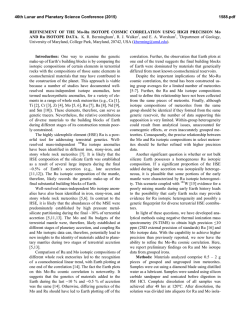
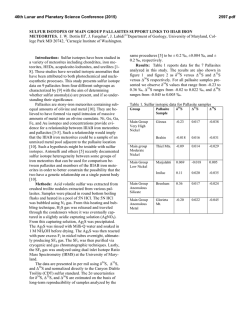
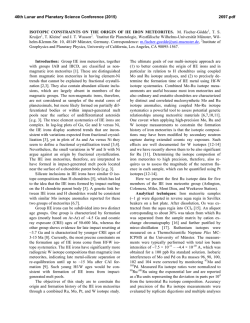
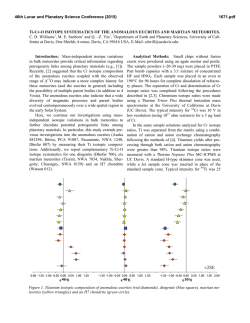
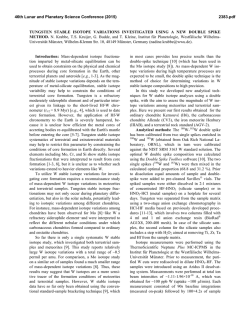
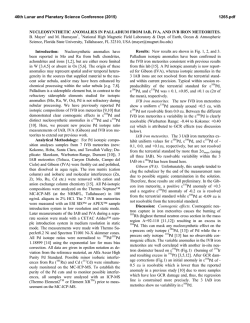
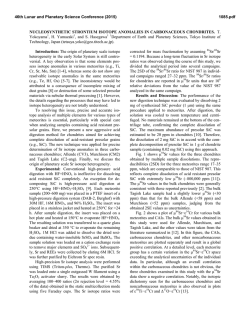
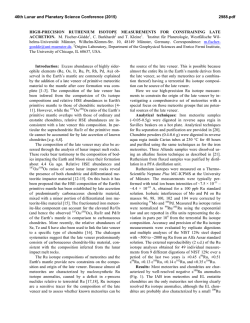
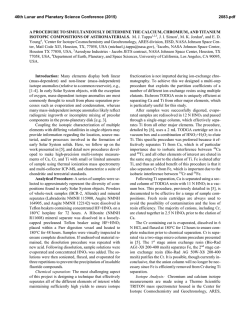
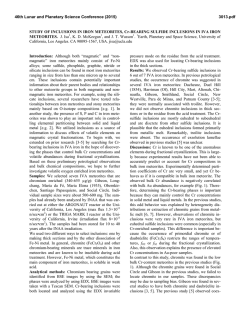
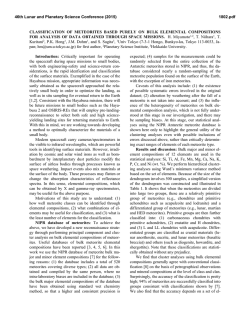
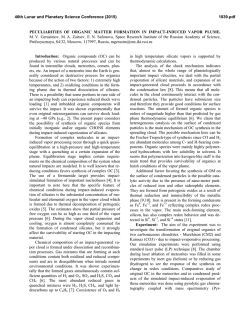
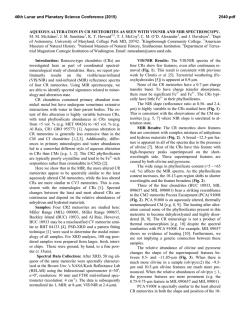
![Download the PDF [178 KB]](http://s2.esdocs.com/store/data/000499344_1-7f4373c1afe39f332b14a8d11d1a7c7f-250x500.png)
